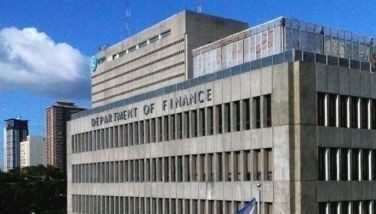Politics and hybrid infra projects

Business held its peace when the government announced mid-year that it would pursue a “hybrid” approach for building projects as part of its grand plan to usher in a golden age in infrastructure for the country.
The first consideration for the muted response was respect for the individual members of President Duterte’s economic team, whose individual track records either in government service or the private sector (or both) were relatively unblemished.
Secondly, there was desperation at the slow pace of project approvals entered under the public-private partnership program through the Public Private Partnership Center. The economy was taking off, and infrastructure projects were just taking too long to start.
The third had something to do with the “honeymoon” concept concerning a newly elected official, especially one who wielded immense public popularity. When the hybrid PPP approach was first broached, President Duterte was barely a year into office.
The Management Association of the Philippines sent a weak statement with a caution buried between the lines of potential corruption issues. The PPP Center detailed a long list of disadvantages, but was quick to suggest a compromise win-win alternative. Everyone wanted to be regarded as a “team player.”
Rushing hybrids
When the President’s economic team talks about the hybrid PPP approach, it generally means the government will source and finance the funds needed for the projects, and once completed, will look for a private partner to operate and maintain the project.
It follows that the government will draw heavily on available or new official development assistance facilities, which are actually loans that carry much lower interest rates, making the project cost lower than if the funds were to be sourced by the private sector, in this case, through commercial lending facilities.
The hybrid approach was also premised on the desire that projects would be churned out at a faster rate, this bias in consideration of the fact that the President’s term was only until 2022.
With one year already past, planning and approval had to be done quickly if these infrastructure projects were to be inaugurated before the administration term ended. What would be all this hullaballoo about a golden age of infrastructure be if nothing substantial would be completed by then?
Modified hybrid
If politics had not been the underpinning rationale for adopting the hybrid formula of the Duterte administration, the PPP Center’s suggested modified hybrid mode would and should have been seriously considered and adopted.
This meant the government could tap ODA sources to reduce the cost of projects, but would leave construction and O&M responsibilities to the private sector. Projects that were still in the pipeline at the PPP Center could easily have required cheaper ODAs as fund sources.
This way, all the solid work that had already been expended by the PPP Center on key infrastructure projects would not have gone to waste, and would have been ready on schedule.
Hybridization has caused delays
But this has not been the case, and instead of seeing projects like the P108.2-billion regional airports approved according to the PPP Center schedule, the hybridization will, in fact, contribute to some delays.
The National Economic Development Authority is saying that PPP will not be totally abandoned, but this seems to be more of a fallback alternative, if the Duterte hybrid formula will not prove to be effective in reducing the time needed get infrastructure projects off the ground.
Corruption
Perhaps the biggest concern that continues to be talked in whispers is the risk of massive corruption rearing its ugly head. The very reason for the existence of PPPs was the long history of government getting mired in under-the-table deals involving construction contracts.
The fact that many of the ODA funds will come from China has warning bells ringing out loud with memories of the infamous $329-million National Broadband Network project by ZTE Corp. involving Chinese government loans.
The Philippine government says that a stopgap to this concern would be due diligence, but we all know that corruption – despite the big talk of our President against any person in his administration found to be tainted with bribery or underhanded dealings – is difficult to avoid in our current government.
Lowest bid is not best bid
Other problems come with the hybrid system, and one of this would be the assurance that the project does not fall victim to the “lowest bid” policy of government where the lowest bid would usually involve cutting corners, some of which could badly damage the final product.
Isn’t this what happened with Metro Manila’s commuter light railway system, something that eventually had to be divided into three modules constructed by three different contractors, and are now operating in the worst dysfunctional way.
Potential conflicts
The other problem, as the PPP Center points out, is the huge potential for conflicts between the government-approved contractor to build the project and the eventual contractor that will run and maintain the project. It’s easy for the O&M contractor to point fingers at the builder for a faulty design.
Amidst all the accusations of mismanagement and incompetence when problems occur, the public is left at a disadvantage. The queues at the gates will persist while the government tries to sort out who is to blame and, more importantly, who shoulders the cost of correcting the mistake.
Reality bites
As the economic team is now experiencing, getting projects – especially complex ones like airports, elevated roads and railways – off the ground is not as easy given their inherent complex nature and the Philippines’ unique problems like right-of-way conflicts.
It would have been best at the start of the current administration’s term to have looked into ways and means of improving and speeding up of the processes that the PPP Center is currently using. The center already has the benefit of having years of experience and good people on board.
Still, with the PPP Center around, and its doors not totally closed, it may not be too late for that win-win solution.
Facebook and Twitter
We are actively using two social networking websites to reach out more often and even interact with and engage our readers, friends and colleagues in the various areas of interest that I tackle in my column. Please like us at www.facebook.com and follow us at www.twitter.com/ReyGamboa.
Should you wish to share any insights, write me at Link Edge, 25th Floor, 139 Corporate Center, Valero Street, Salcedo Village, 1227 Makati City. Or e-mail me at [email protected]. For a compilation of previous articles, visit www.BizlinksPhilippines.net.
- Latest
- Trending




























